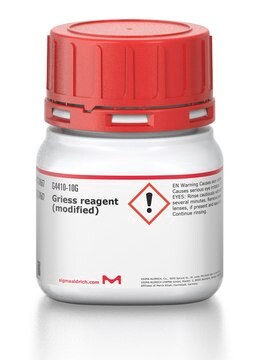482655
Nitric Oxide Assay Kit, Fluorometric
Synonyme(s) :
NO, Nitric Oxide
About This Item
Produits recommandés
Utilisation
sufficient for 192-288 tests
Niveau de qualité
Conditionnement
pkg of 1 96-well plate(s)
Fabricant/nom de marque
Calbiochem®
Conditions de stockage
OK to freeze
Entrée
sample type aqueous solution(s)
Méthode de détection
fluorometric
Température de stockage
−20°C
Description générale
Composants
Avertissement
Caractéristiques
Notes préparatoires
Stockage et stabilité
Autres remarques
Misko, T.P., et al. 1993. Anal. Biochem. 214, 11.
Green, L.C., et al. 1982. Anal. Biochem.126, 131.
Informations légales
Mention d'avertissement
Danger
Mentions de danger
Classification des risques
Acute Tox. 3 Oral - Aquatic Acute 1 - Eye Dam. 1 - Met. Corr. 1 - Ox. Liq. 3 - Resp. Sens. 1 - Skin Corr. 1A
Code de la classe de stockage
5.1B - Oxidizing hazardous materials
Certificats d'analyse (COA)
Recherchez un Certificats d'analyse (COA) en saisissant le numéro de lot du produit. Les numéros de lot figurent sur l'étiquette du produit après les mots "Lot" ou "Batch".
Déjà en possession de ce produit ?
Retrouvez la documentation relative aux produits que vous avez récemment achetés dans la Bibliothèque de documents.
Notre équipe de scientifiques dispose d'une expérience dans tous les secteurs de la recherche, notamment en sciences de la vie, science des matériaux, synthèse chimique, chromatographie, analyse et dans de nombreux autres domaines..
Contacter notre Service technique








